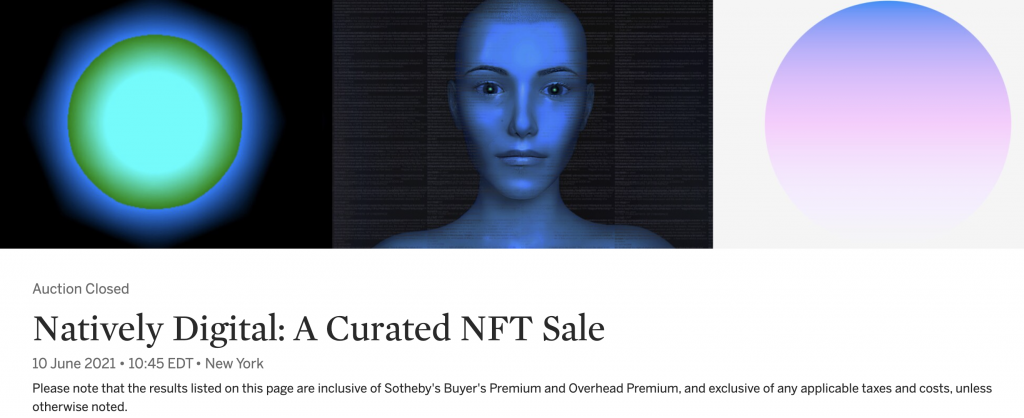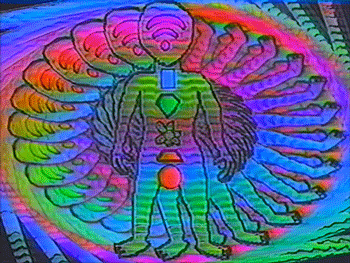NFT is the abbreviation for the non-fungible token which means that it can’t be replaced. If placing the NFT concept in the art world, it actually shares similar value as authentic artworks, as both of them mean that it is the only edition of work in the world. For example, Mona Lisa is the only painting of its kind in the world. The second part of NFT is the token which is a concept from blockchain that allow the financial transaction between two parties without banks. Instead of using common currency to trade artworks, in the NFT space, collectors can buy and sell works using Ethereum wallet ID to have a secure and transparent transaction by using blockchain. This article only considers the visual art expression of NFT in the blockchain space.
“NFT’s are birth certificates for the offspring of creators.” Dane Scarborough
To investigate NFT in the realm of artwork, it would be valuable to investigate the production process of NFT as compared to the traditional artwork. Many of the NFTs are created from tangible or intangible materials, for example, a securitized version of crypto art, a TikTok video, or even a tweet. To some extent, NFT can act as the common middle ground for transactions rather than the actual creation of artwork.
The way of minting an NFT by uploading media to the platform requires the form of pre-existing creation. Each artwork minted on platforms such as Opensea, NiftyGate, and Foundation contains a unique identifier for the artwork providing the contract address that allows open access to the public record of provenance, price, ownership, and authenticity. The transparency of the transaction also allows artists to track them and receive royalties from future transactions. In the other words, NFT transfers the artwork from the traditional commissioned artwork trading to a free market where the artists can sell their works directly to their fans.
It is right to be concerned, will digital art assets’ rising market bring a synergy or cannibalization effect to the traditional art enterprise?
The NFT market has experienced three different stages, (1) the emergence of the art market where only a few NFT artists enter the market (Jan 2021 – July 2021), (2) the growth of the market (August 2021 – December 2021), (3) the continuous booming of the market. The sales data of NFT artwork indicates strong growth from 2021 to 2022. The exponential growth curve suggests much more potential in the future as it emerges in many market segments. There is no doubt that the art world is disturbed by the NFT art as it rapidly inflates. It is hard to predict when and how this overblown bubble will burst in the short term. Yet, in the long term, it will be an add-on value to the art enterprise by creating more opportunities. I argue that it poses an augmented effect on the art market at large.
Decentralized NFT Business Model
The business models and underlying logics of trading art as a form of NFT and trading physical art are very distinctive.
It is right to ask the question if NFT is the placement or extension of the art market?
There are five categories when considering the intervention of NFT in the art world, business model, product, target customers, pricing strategies, and marketing. The foundational technical difference alters the product type from physical to digital, which expands the distribution channel from offline to online. It also changes the idea of patent and copyright in trading an art piece. NFT buyers only purchase the digital copy of the work with the possibility of transferring the copyright and IP with the artists’ permission. Whereas in trading physical artworks, the collector owns the physical object of the artwork without the copyright. Most of the time, artists wouldn’t be related to the later transactions and receive the royalties.
Like the business model shown below, the traditional art enterprise model is heavily centralized with the informal network as all the artists rely on dedicated arts institutions and organizations that have a network of collectors and resources to sell their artworks. Gallery selects artists based on their medium, art education institution, the number of gallery/museum shows, and previous collectors. This highly competitive process excludes those who may have strong artistic talent, but don’t have the required art education from renowned institutions. Or they also exclude artists who practice highly experimental art that is hard to collect, sell and maintain.
The target consumers for physical artworks are rather exclusive as they only focus on collectors who already have the credential of developing a valuable collection or have prior collecting experience. Because of the exclusivity of the collector community, the marketing of the artwork is mostly through collector’s dinner, word of mouth, and digital channels. The transaction happens privately and the artists make living out of the commission, which is around 50%.
The NFT and the rising of web3 are interruptable and decentralized which allows people from different industries and sectors to interact. The barriers to entry are fairly low. By providing the opportunity to trade outside of the art enterprise, it interrupts the traditional art business ecosystem, such as galleries, auction houses, and individual collectors. It is a public trading platform that enables free buying and selling. Anyone with access to the internet and a digital wallet can purchase NFT artworks, at the same time, any artist can publish their artworks for sale without any qualification scannings. The success of NFT trading depends on the marketing and demand from the market. The selling of the artwork is identical to the auction business model, such as the Artnet auction. The artist lists the artworks and prices them accordingly, and the collector needs to bid to purchase them.
It provides opportunities for emerging artists to showcase their artworks and have the opportunities to sell them. However, it is important to note that in a free market environment with many small players, it is more difficult for individuals to gain market share and make a profit. Visual artists are not only competing with other visual artists, for example, painters, sculptors, and photographers. The borderless NFT market also attracts other creators, such as graphic designers, cartoonists, musicians, and architects. A question arises, is the NFT market creates more opportunities or more competitiveness?
The social network between artists and collectors
Many NFT platforms function as social platforms where collectors can follow NFT artists. This NFT platform business model is very similar to YouTube’s subscription model. The collector community determines the potential of NFT artists through the number of followers and their levels of popularity. Twitter is one of the main marketing channels for NFT artists, thus the relationship between Twitter and NFT marketplace has a high correlation. The visibility on social media, like Twitter has a great impact on the total earnings. It has a strong positive correlation that artists with a greater amount of followers obtain higher earnings. However, the diagram on the left indicates a stronger correlation that artists who have a greater number of followers on the NFT trading platform earn more as compared to Twitter.
Branding and Pricing in the Digital Space
The pattern of artist success in the traditional art business is dependent on the growing reputation of artwork and the number of sold artworks. The price and the growth are managed and maintained by the galleries. Galleries act as gatekeepers and marketing agencies to make sure artists fit into the market need and demands. This usually is done formally by press release, artist interview, and critique article. As the NFT space lacks the gatekeepers, and artists need to market themselves like YouTubers, it is curious to learn about the changes in the pattern of success.
Can artists with no marketing resources and budget make more money out of making or turning their artwork to NFT as compared to the traditional art enterprise?
Artists need to place multiple hats on themselves to become an artist, a marketer, and a dealer in order to succeed. The heavy emphasis on marketing and commercialization embedded in the nature of NFT artwork ultimately takes away some of the artistic value. It is also difficult for those who don’t have adequate marketing experience to navigate the market. Yet, it helps develop an integrated business model like Sotheby’s NFT auction, where NFT artworks developed by visual artists are listed through Sotheby’s platform.

Web3 has changed the value chain of pricing and valuation of an art piece. The value of artwork no longer relies heavily on artists, concepts, materials, and curatorial studies, but is closely related to consumerism, economic factors, and the demand for the object in the second-hand market. In the art world, there are three main reasons why a digital-oriented collector would like to purchase a work of art, to support the artist, to establish the social status, and to invest. The ownership of a physical artwork is both the representation of social legacy but also a form of social currency. But for NFT art, why do people need to purchase an object, if they can look at it for free?
Collecting an NFT artwork is purchasing a digital asset. Collectors purchase the version of the media as a form of NFT in the digital marketplace as an act of investment and financial parking. It is also a form of owning a virtual currency in the metaverse.
Future of Gallery and Auction House
After analyzing the NFT marketplace from diverse perspectives, I perceive NFT as an extension of the booming Metaverse, which can be a valuable add-on opportunity for the art world. It brings dynamic artistic products which invent a one-of-its-kind model of transaction. I think it brings in more synergy effect than cannibalization as many of the auction houses started to incorporate NFT art into their business. For instance, the video NFT artwork, Self Transcending by Sara Zucker was listed on Sotheby’s NFT auction platform and the final sale price is $22,680.

It opens the door for multi-media artwork that seems unfavorable to many collectors, at the same time expanding the market size of the art world. It is right to forecast that the incorporation of the auction house and NFT artwork is not the only form of collaboration in the art enterprise. As the NFT marketplace becomes more prevalent along with the growth of the metaverse, more creative interventions of business innovation will appear.
Reference
Anthony, Daniel, and Akiv Jhirad. “Commercializing NFTs – Generating Value from Digital Assets and Intellectual Property Rights,” n.d., 6.
Breen, Nick. “With New NFT Projects Granting Commercial Usage Rights and Copyright Assignments to Holders, We Are Beginning to See the Friction between the Promises of Web3 and the Rigidity of Traditional Copyright Principles. Where NFTs Are Traded like Stocks on Open Marketplaces, What Do Buyers and Sellers Need to Know? We Take a Look from an English Law Perspective.,” n.d., 5.
Conti, Robyn, and John Schmidt. “What Is An NFT? Non-Fungible Tokens Explained,” n.d., 25.
Dash, Anil. “NFTs Weren’t Supposed to End Like This.” The Atlantic, n.d., 6.
Franceschet, Massimo, Giovanni Colavizza, Tai Smith, Blake Finucane, Martin Lukas Ostachowski, Sergio Scalet, Jonathan Perkins, James Morgan, and Sebastian Hernandez. “Crypto Art: A Decentralized View.” ArXiv:1906.03263 [Cs], June 9, 2019. http://arxiv.org/abs/1906.03263.
Hammer, Sarah. “PHOTO: ALEXI ROSENFELD/GETTY IMAGES,” n.d., 4.
Khalil, Nadine. “NFTs and the Future of the Art World,” n.d., 7.
Kugler, Logan. “Non-Fungible Tokens and the Future of Art.” Communications of the ACM 64, no. 9 (September 2021): 19–20. https://doi.org/10.1145/3474355.
Romeo, Jess. “Thirty Years after the Invention of Blockchain, an Artist Sold a JPG Using That Technology for Nearly $70 Million. Huh?,” n.d., 5.
Vasan, Kishore, Milán Janosov, and Albert-László Barabási. “Quantifying NFT-Driven Networks in Crypto Art.” Scientific Reports 12, no. 1 (December 2022): 2769. https://doi.org/10.1038/s41598-022-05146-6.
Wong, Jessica. “What Are NFTs And How Do You Market Them Effectively?,” n.d., 6.